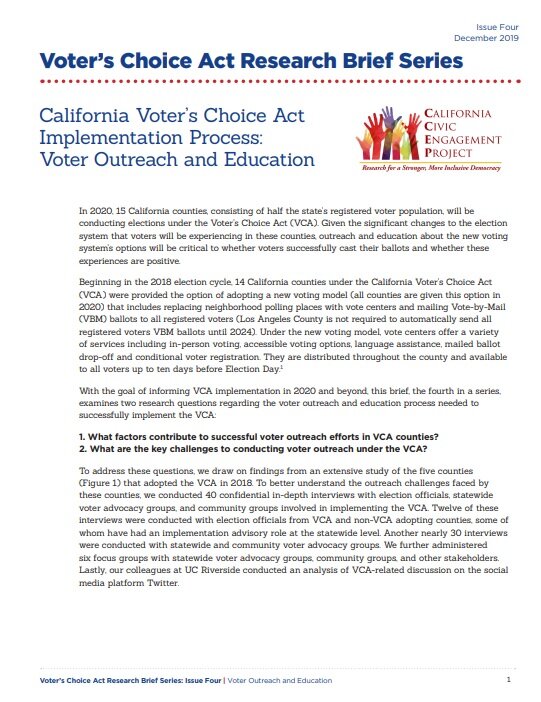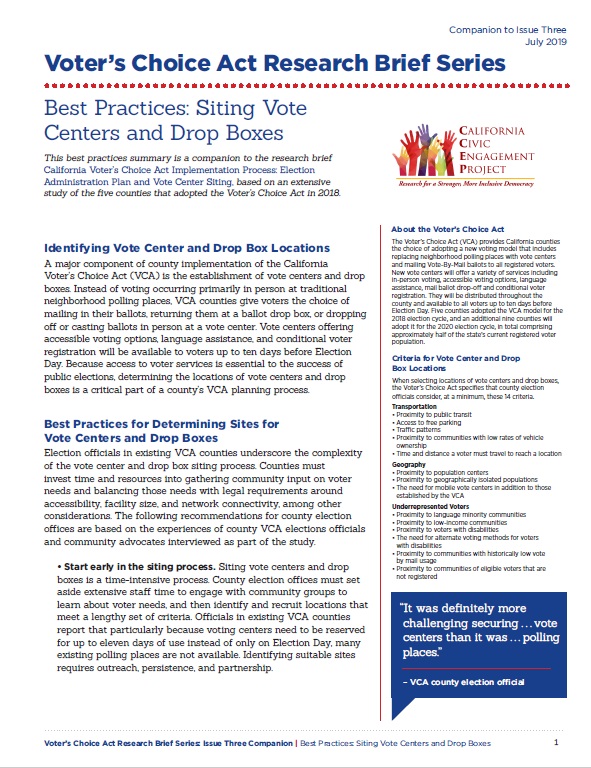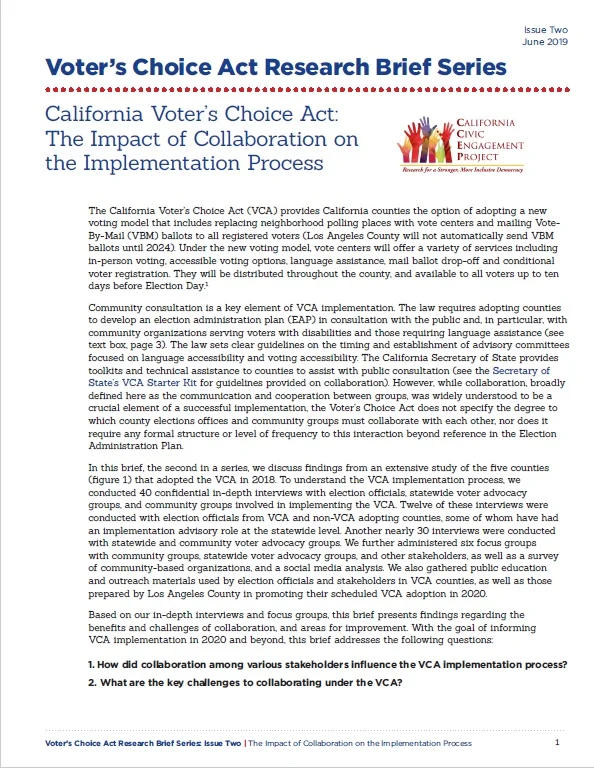California Voter’s Choice Act Implementation Study
2018 Election Cycle
Resource Center
about the Study:
The Voter's Choice Act Implementation Study was designed to provide a better understanding of how the Voter’s Choice Act (VCA) was implemented in California during the 2018 Primary and General Elections. The study's goal was to identify key successes, challenges, and lessons learned from the implementation of the VCA in the five participating counties for the 2018 election cycle. This research was intended to assist counties that will be adopting the VCA in 2020 to do so effectively, in ways that optimize voters’ experiences.
This research was led by the Center for Inclusive Democracy at USC, formerly California Civic Engagement Project, with deep and ongoing contributions by the Center for Social Innovation at UC Riverside and Catherine Hazelton of Hazelton Strategies. We would also like to thank Fontane Lo for her insight and contributions to the study’s research design and publications. The research was supported by The James Irvine Foundation.
Study Advisory Committee:
Courtney Bailey-Kanelos, Sacramento County Registrar of Voters
Elba Gonzalez-Mares, Executive Director, Community Health Initiative (CHI)
Joe Holland, Santa Barbara County Clerk, Recorder, Assessor and Registrar of Voters
Jim Irizarry, San Mateo County Assistant Assessor-County Clerk-Recorder and Chief Elections Officer
Dean Logan, Los Angeles County Registrar-Recorder/County Clerk
Rebecca Martinez, Madera County Clerk, Recorder, and Registrar of Voters
Fred Nisen, Supervising Attorney for Voting Rights, Disability Rights California
Astrid Ochoa, Executive Director, Future of California Elections
James Schwab, Chief Deputy Secretary of State, California Secretary of State Alex Padilla
Cha Vang, Executive Director, Hmong Innovating Politics (HIP)
James Woodson, Manager of Policy and Strategic Projects, California Calls
Publications:
CALIFORNIA VOTER’S CHOICE ACT: ISSUE Four
Implementation Process: Voter Outreach and Education
This is the fourth brief in a series of VCA research briefs. It examines the voter outreach and education process needed to successfully implement the Voter’s Choice Act, based on an extensive study of the five counties that adopted the Voter’s Choice Act in 2018.
CALIFORNIA VOTER’S CHOICE ACT: ISSUE Four
Best Practices: Conducting Voter Outreach and Education
This best practices summary is a companion to the research brief California Voter’s Choice Act Implementation Process Voter Outreach and Education, based on the CCEP’s extensive study of the five counties that adopted the Voter’s Choice Act in 2018.
CALIFORNIA VOTER’S CHOICE ACT: ISSUE Three
Implementation Process: Election Administration Plan and Vote Center Siting
This is the third brief in a series of VCA research briefs. It examines the EAP and Vote Center siting process from the perspectives of VCA county elections officials and community advocates.
CALIFORNIA VOTER’S CHOICE ACT: ISSUE Three
Best Practices: Developing an Election Administration Plan
This best practices summary is a companion to the research brief California Voter’s Choice Act: Implementation Process: Election Administration Plan and Vote Center Siting, based on the CCEP’s extensive study of the five counties that adopted the Voter’s Choice Act in 2018.
CALIFORNIA VOTER’S CHOICE ACT: ISSUE Three
Best Practices: Siting Vote Centers and Drop Boxes
This best practices summary is a companion to the research brief California Voter’s Choice Act: Implementation Process: Election Administration Plan and Vote Center Siting, based on the CCEP’s extensive study of the five counties that adopted the Voter’s Choice Act in 2018.
CALIFORNIA VOTER’S CHOICE ACT: ISSUE TWO
THE IMPACT OF COLLABORATION ON THE IMPLEMENTATION PROCESS
This is the second brief in a series of VCA research briefs. It examines the role of collaboration in the VCA implementation process from the perspectives of VCA county elections officials and community advocates.
CALIFORNIA VOTER’S CHOICE ACT: ISSUE TWO
Best Practices: Collaboration to Support Implementation
This best practices summary is a companion to the research brief California Voter’s Choice Act: The Impact of Collaboration on the Implementation Process, based on the CCEP’s extensive study of the five counties that adopted the Voter’s Choice Act in 2018.
CALIFORNIA VOTER’S CHOICE ACT: ISSUE ONE
KEY CONSIDERATIONS ON IMPLEMENTATION
This research brief presents findings from the VCA Implementation Study, with the goal of informing VCA implementation in 2020 and beyond. It is produced through a partnership of the California Civic Engagement Project at USC and UCR's Center for Social Innovation. The brief presents recommendations from elections officials for counties considering VCA adoption.
Other Available Resources:
California Secretary of State: VCA Quick Start Guide - This quick start guide is designed to be a supplement to the Voter’s Choice Act (VCA) Starter Kit developed by the Secretary of State’s Voter’s Choice Act Team. This quick starter kit is intended to be used as a starting point for county elections administrators that are considering adopting the Voter’s Choice Act model for election administration in their county.
California Secretary of State: VCA Starter Kit - This Starter Kit to the Voter’s Choice Act (VCA) is designed as a collection of resources and in-depth references. These materials and documents were developed by many of the stakeholders (county, state, and NGO) that participated in the implementation and planning process for the first Voter’s Choice election in 2018.
League of Women Voters of California VCA Toolkit for Community Organizers - The Voter’s Choice Act Toolkit is a compilation of resources and strategies to help community organizations promote public understanding and drive successful implementation of the Voter’s Choice Act.
Voter’s Choice California: Strategies for Voter Education and Outreach Under the Voter’s Choice Act - This report is a summary of the lessons discussed at the Redwood City convening on July 17, 2018 as well as insights from Future of California Elections’ experience in managing our statewide Voter’s Choice California project.
Voter's Choice California - Voter’s Choice Act Implementation: Building a VCA Coalition - This report highlights best practices for building a local VCA coalition, including recommendations for coordinating partners and working with local election officials.
Voter’s Choice California: Education Tools and Resources - Voter’s Choice California seeks to support communities transitioning to the Voter’s Choice Act. The VCC is comprised of a diverse Statewide Coalition and several Local Hubs that focus on participating counties. It is supported by Future of California Elections staff and a small Steering Committee.
The New Electorate Study: How Did the Voter’s Choice Act Affect Turnout in 2018? - Funded by the University of California’s Office of the President, this project brings together faculty members, graduate students and undergraduates at five UC campuses with collaborators at USC and the Public Policy Institute of California.
Other CCEP Vote Center Research - To better understand the experiences that California voters have with the different available methods for casting ballots, the CCEP conducted a multi-method research study (statewide survey and focus groups) entitled The California Voter Experience Study.
CCEP Vote Center Siting Tool - Developed by the California Civic Engagement Project (CCEP), this mapping tool is designed to provide assistance to California county election offices seeking to implement the Voter's Choice Act in future elections. The goal of this tool is to help election officials identify optimal sites for potential Vote Center and Vote-by-Mail drop boxes.
About the Voter’s Choice Act:
In 2016, Governor Jerry Brown signed Senate Bill 450, known as the Voter's Choice Act (VCA), which allows counties to chose to adopt a new voting system. In counties choosing to adopt the new model, every registered voter is mailed a Vote-by-Mail (VBM) ballot, which voters can either mail in, or return at a ballot drop box or a newly established vote center. At vote centers, which replace traditional neighborhood polling places, voters can cast their ballots in person, drop off their completed VBM ballots, access conditional voter registration, receive replacement ballots, and access additional resources, such as language assistance and accessible voting machines. While there are fewer vote centers than polling places by design, vote centers are open to voters for up to ten days prior to Election Day and available for all voters to utilize countywide. The expectation is that voters could choose to cast their vote by mail or drop box, and those desiring an in-person experience (e.g., using an accessible voting system, location convenience or for a sense of community) would have numerous dates to do so rather than just one. Fourteen of California’s 58 counties were eligible to adopt the model for the 2018 election cycle, and five counties did so—Madera, Napa, Nevada, Sacramento and San Mateo. All other California counties are eligible to adopt the model in 2020. In 2020, Los Angeles County will opt in to the model but will not be required to mail all registered voters VBM ballots until 2024. In addition to Los Angeles County, the following counties have publicly announced that they will adopt the VCA for the 2020 election cycle: Amador, Butte, Calaveras, El Dorado, Fresno, Mariposa, Orange, Santa Clara, and Tuolumne. All together, fifteen California counties will be conducting elections under the Voter’s Choice Act in 2020—approximately half the state’s current registered voter population.









